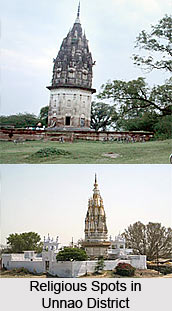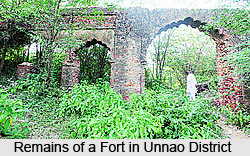 Tourism in Unnao District is popular among travellers owing to its religious and historical significance. Unnao District is a district of Uttar Pradesh and is part of Lucknow Division. Tourism in Unnao District includes a visit to the religious sites and historical monuments. The district is home to a number of villages which narrate different mythological as well as historical tales. A number of temples and mosques are to be found in the villages of this district.
Tourism in Unnao District is popular among travellers owing to its religious and historical significance. Unnao District is a district of Uttar Pradesh and is part of Lucknow Division. Tourism in Unnao District includes a visit to the religious sites and historical monuments. The district is home to a number of villages which narrate different mythological as well as historical tales. A number of temples and mosques are to be found in the villages of this district.
Attractions of Badarqa Harbans Village
One of the centres of tourism in Unnao District is the village of Badarqa Harbans that lies about 11 kilometres south of Unnao near Achalganj at a distance of 3 Km west of Unnao - Rae Bareli road. It was founded in 1643 AD by Raja Harbans, an official at the court of Shah Jahan, who received a grant of 500 Bighas from the Emperor in Pargana Harha. He built a fine house here with walls of limestone blocks to a height of about 500m, surmounted with turreted walls, on an elaborate frieze of red stone over the gateway, having alternately geese and elephants in pairs. A large hall of audience supported on carved pillars formerly stood here, but Asaf-ud-daula is said to have taken these pillars to help building Imambara at Lucknow.
Attractions of Baksar
Besides this, the travellers can also explore Baksar. It is the south most village of the district, lies on the left bank of the Ganga river, about 5 kilometres south of Daundia Khera and 51 km south-east of Unnao. The place is said to derive its name from a Sanskrit word Bakasram denoting the residence of Baka, a rakshas, who founded a town at the site of the present village. He lived here and erected a temple to Nageshwar Nath Mahadeo. Baka is said to have been killed by Lord Krishna. It is also said that Raja Abhai Chand, a Bais Rajput, conquered the place naming it after the shrine of Bakeshwar Mahadeo and made it its capital. Ram Bakhsh Singh, the Raja of Daundia Khera, who took an active part in the freedom struggle in 1857, was hanged here on a tree over a temple which was also blown up by the British. The ruins of the temple and several broken images are still found in the village. A bathing fair, attended by a large number of people, is annually held here on the full moon day of Kartika.
Attractions of Newal Town
The ancient town of Newal was occupied by Raja Nal, a local ruler and is traditionally associated with ancient site of `Alavi` of the Buddhist records and `Navadevakula` of Huien Tsang`s travel accounts. According to Buddhist literature, Lord Buddha stayed here for sometime and preached the gospel. The antiquity of the place is attested by the discovery of earthen black polished wares and other archaeological finds. A terracotta piece, in particular, representing `Aradhanarishwari,` is a rare specimen of its kind in India. It was found here and is displayed in the National Museum. The other interesting objects found here include Manshila Mandir, Davendihar and Mahadeo Phulwari.
The Budhawa Mangal fair is held here on the first Tuesday of the Chaitra month. Two other fairs are also organised here by the villagers. One of them is the Baboo Mian ka Mela. It is held on the first Tuesday of Chaitra, and the other fair is known as Shitala Devi which falls on the 8th day of the bright half of the same month.
Attractions of Daundia Khera
Also known as Sangrampur, Daundia Khera lies on the high bank of Morahi (Naurahi) river about 5 km west of the Unnao-Dalmau road and 29 km south of Purwa. About 13th century, Abhai Chand, a Bais Rajput, drove out the Bhars of Daundia Khera, after fighting a fierce battle. Abhai Chand gave the name of Sangrampur to the village where he fought the battle. Since then it formed the home of the great Bais clan of Rajputs. Ram Bux Singh, talukdar of the place and a descendent of Abhai Chand, was hanged here for participation in the freedom struggle of 1857.
 Attractions of Mohan
Attractions of Mohan
Mohan, a considerable village lies on the left bank of the Sai river, about 6 km east of Hasanganj and 38 km north-east of Unnao. Roads lead from this place to Malihabad in Dist. Lucknow on the east, Nawabganj on the south and Bangarmau on the north-west. During the days of the Nawabs of Avadh, it was an important town, of which many residents found employment in the court of the Nawab and earned large fortunes. The town was well known for its Unani Hakims, mimics and actors. To the south of the village near the Sai, is a high mound, supposed to be the remains of an ancient fort. On this mound is an old tomb of a Muslim saint.
Attractions of Nawabganj
Nawabganj lies on the Lucknow-Kanpur National Highway, about 20 kilometre North-East of Unnao. It was founded in 1842 by Amin-Ud-Daulah, the prime minister of Avadh, who built a serai or inn and a mosque which are still in good condition.
Attractions of Pariyar
Pariyar, which gives its name to a Pargana, lies on the left bank of the Ganga at a distance of about 23 km north-west of Unnao. In the vicinity of the village lies the Mahua Lake. Tradition has it that in the Treta yuga, Lakshmana at the behest of his brother Rama, accompanied Sita to her banishment to this place, which in consequence, came to be known as Parhar, a Sanskrit word meaning abandonment. With the passage of time, the name Parhar has been converted to Pariyar. It was here that Sita gave birth to Lava and Kusha who were trained in archery by Valmiki, and grew up to be accomplished warriors. They caught Shyambaran, a horse loosed by Lord Rama during Aswamedh Yajna arranged by him and this gave a signal of for a war between Rama and his Sons whom he did not know.
The village is said to have been founded in the 12th century by Himachal Singh, a Dikhit Thakur. The place houses two temples: Balkaneshwar Nath Mahadeo, said to have been built by Lava and Kusha and the other is of Janki.
Attractions of Patan
Patan lies on the road from Unnao to Allahabad via Achalganj, about 16 kilometres south of Purwa. The Rae Bareli-Kanpur branch of the Northern Railway passes by the village which has a Railway station, Takia. The village houses a temple dedicated to Lingeshwar Mahadeo, the Tomb of Muhabbat Shah, and an ancient mound ascribed to the Bhars. A large fair known as Takia - Ka - Mela, is held here on the 1st Thursday of Paus month, in honour of Niamat Shah. The latter was a disciple of Muhabbat Shah, a darvesh, who was a contemporary of Shuja-Ud-Daulah and Asaf-ud-daula, nawabs of Avadh.
Attractions of Safipur
Safipur lies on the Unnao-Hardoi road about 27 km north-west of Unnao. It is said to have been named after a dervesh Makhdum Shah Safi. He was buried here and the place assumed the name Safipur. Safipur forms the last resting place of several other darveshes also of whom the chief are Ifhamullah, Kudrat-ullah, Hafiz-ullah and Abdullah.
A famous mausoleum over the remains of the darvesh Safi was erected here. Small Urs fairs are held here on the 12th and 22nd day of Rabi-ul-awwal, 20th day of Jamat-us-sani, 12th and 14th days of Rajjab, 8th day of Ramzan and 14th day of Zilhaj.



















